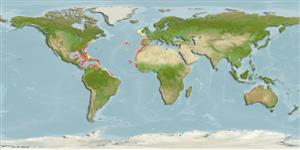Environment: milieu / climate zone / depth range / distribution range
Ecology
Marine; bathydemersal; depth range 170 - 594 m (Ref. 13707). Deep-water
North Atlantic: west from off Key West, Florida to Georgia; in the east from Portugal, Meteor Bank, Josephine Bank, Madeira and off Casablanca, Morocco.
Size / Weight / Age
Maturity: Lm ? range ? - ? cm
Max length : 11.0 cm SL male/unsexed; (Ref. 52964)
Found in deep water, 150-600 m, on muddy bottoms. Feeds on benthic invertebrates, mainly worms and crustaceans (Ref. 53643).
Life cycle and mating behavior
Maturity | Reproduction | Spawning | Eggs | Fecundity | Larvae
Fricke, R., 1992. Revision of the family Draconettidae (Teleostei), with descriptions of two new species and a new subspecies. J. Nat. Hist. 26(1):165-195. (Ref. 13707)
IUCN Red List Status (Ref. 130435: Version 2024-2)
Threat to humans
Harmless
Human uses
Tools
Special reports
Download XML
Internet sources
Estimates based on models
Preferred temperature (Ref.
123201): 11.4 - 19.6, mean 14.9 °C (based on 72 cells).
Phylogenetic diversity index (Ref.
82804): PD
50 = 0.5001 [Uniqueness, from 0.5 = low to 2.0 = high].
Bayesian length-weight: a=0.00389 (0.00180 - 0.00842), b=3.12 (2.94 - 3.30), in cm total length, based on all LWR estimates for this body shape (Ref.
93245).
Trophic level (Ref.
69278): 3.5 ±0.44 se; based on food items.
Fishing Vulnerability (Ref.
59153): Low vulnerability (10 of 100).
